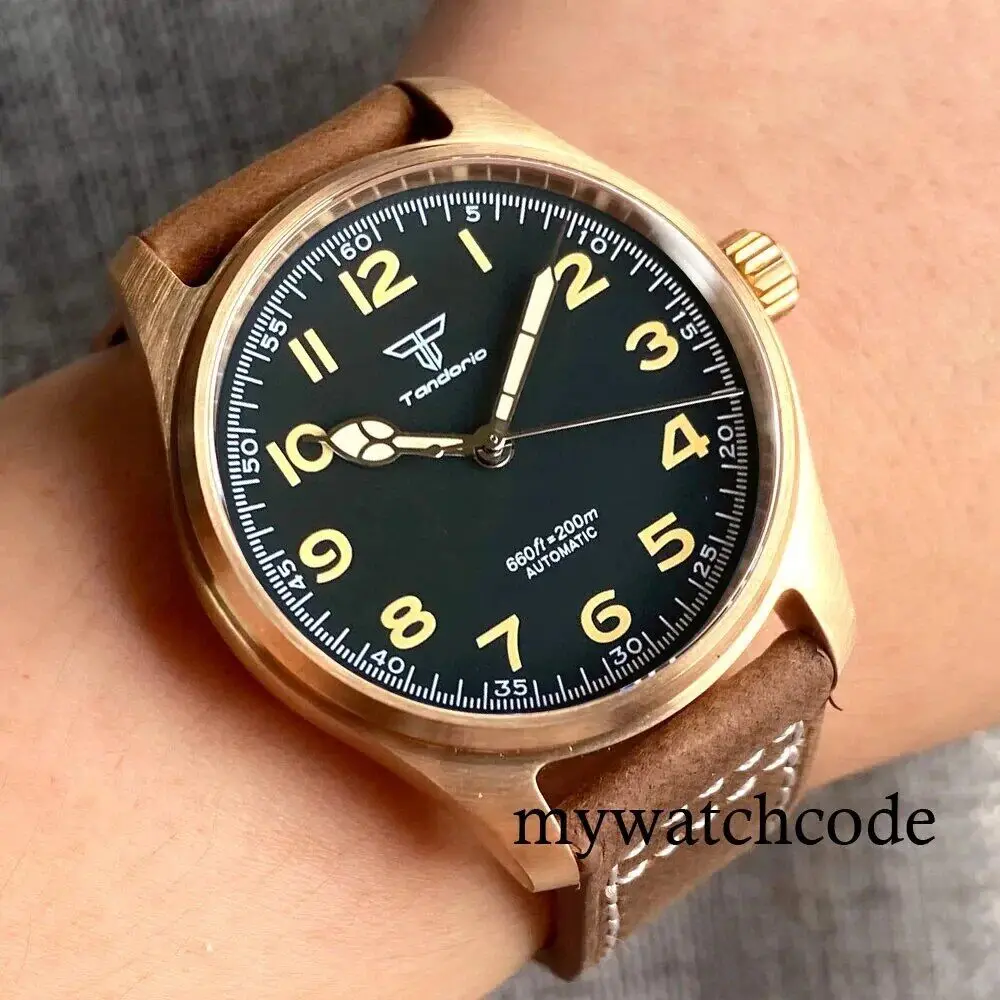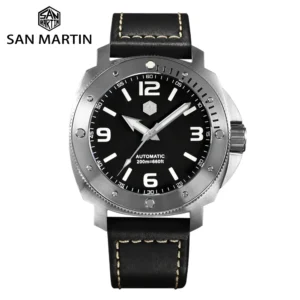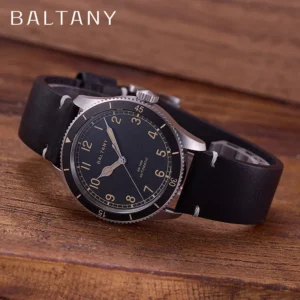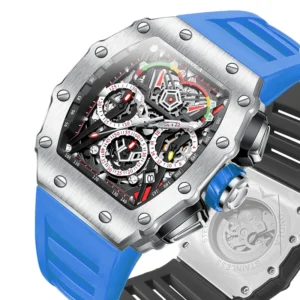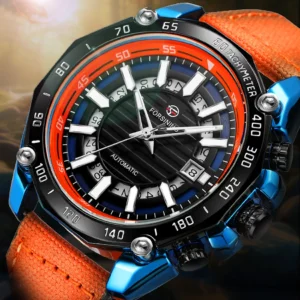Understanding Bronze Patina: The Natural Transformation Process
Bronze watches have captivated enthusiasts worldwide, not just for their warm golden hue when new, but for their remarkable ability to transform over time. This transformation, known as patina, is more than just an aesthetic change—it’s a fascinating scientific process that gives each timepiece its unique character.
At its core, patina is an oxidation reaction. When bronze—typically an alloy of copper with tin, aluminum, or other metals—comes into contact with oxygen, moisture, and other environmental elements, the copper molecules on the surface undergo a chemical reaction. This reaction creates a thin layer of copper oxide (Cu + O₂ → CuO), which serves as a protective barrier for the metal underneath.
What makes patina so intriguing is its dual nature: it’s both decorative and functional. While creating beautiful colors ranging from warm browns to greens and blues, this layer actually shields the underlying metal from further corrosion. Think of it as the watch developing its own natural armor.
The speed at which this transformation occurs varies dramatically based on multiple factors—from the specific bronze alloy used to the environments the watch experiences. Even the unique chemistry of the wearer’s skin plays a significant role in how the patina develops.
Bronze watches have a rich history, particularly in maritime settings where their corrosion resistance made them ideal for tough conditions. The natural aging process of these timepieces connects modern wearers to the history of dive watch engineering and traditional craftsmanship.
What truly sets bronze watches apart is that no two will age exactly alike. Each develops its own distinctive character—a visual story of its journey with you—making your timepiece truly one of a kind.
The Composition Factor: How Bronze Alloy Affects Patination
Not all bronze watches patina at the same rate or develop identical colors—and the secret lies largely in their composition. The term “bronze” actually encompasses a family of alloys, each with distinct patination behaviors based on their specific metal makeup.
The primary bronze alloys used in watchmaking include:
CuSn8 (Traditional Tin Bronze): Containing approximately 92% copper and 8% tin, this classic bronze alloy develops a rich, deep patina relatively quickly. Its patina typically ranges from chocolate browns to darker green-brown hues.
CuAl (Aluminum Bronze): With aluminum replacing tin as the secondary metal, this alloy generally patinates more slowly and produces lighter, more golden-hued patina. Many watch enthusiasts prefer this alloy for its subtle aging process.
Phosphor Bronze: Containing small amounts of phosphorus, this variant develops distinctive reddish-brown tones and patinates at a moderate rate.
The percentage of copper in the alloy significantly affects oxidation speed—generally, higher copper content leads to faster patination. Meanwhile, the secondary metals (tin, aluminum, or zinc) not only influence the speed but also determine the characteristic colors that develop.
Understanding the bronze case oxidation explained helps collectors appreciate why different watches age differently. Some brands deliberately choose specific alloys to achieve particular patination characteristics—slower-developing golden hues versus quicker-forming dark patinas.
When exploring bronze automatic watches, you’ll notice these variations in composition create fundamentally different “canvases” upon which environmental factors will work their magic. A watch with CuSn8 alloy taken to the beach will react quite differently than an aluminum bronze piece exposed to the same conditions.
This composition factor forms the foundation of patina development, but it’s just the beginning. How quickly your bronze watch transforms also depends heavily on the environmental conditions it encounters throughout its life with you.
Environmental Accelerators: Air, Water and Salt Exposure
While a bronze watch’s composition establishes its baseline patination tendency, environmental factors are the primary drivers determining how quickly that patina develops. These elements can dramatically accelerate or slow the oxidation process.
Oxygen Exposure
The very air around us contains the oxygen necessary for patination to begin. Higher oxygen concentration leads to faster oxidation, though this factor alone typically creates a slow, even patina. Indoor environments with climate control generally allow for a gradual, controlled patination process.
Moisture and Humidity
Water is perhaps the most significant patina accelerator. In dry desert climates, bronze watches patinate very slowly, while those in tropical, humid environments can develop noticeable patina within weeks. Moisture provides the medium needed for more complex oxidation reactions to occur, especially when combined with other environmental elements.
Saltwater: The Ultimate Accelerator
Nothing transforms bronze faster than exposure to salt. Saltwater or salt air (common in coastal environments) rapidly accelerates oxidation, creating distinctive blue-green patinas rich in character. This explains why bronze has such strong connections to the evolution of dive watch technology, as these watches often develop beautiful patinas when used for their intended purpose.
However, collectors should note an important distinction: while normal patina protects bronze, excessive chloride exposure can lead to “bronze disease”—a destructive form of corrosion that continues even after drying and can permanently damage your watch.
Temperature Effects
Chemical reactions, including oxidation, occur faster at higher temperatures. A bronze watch worn in hot conditions will generally patinate more quickly than one kept in cooler environments. This factor combines with humidity to explain why tropical climates create such rapid patination.
These environmental factors rarely work in isolation. A bronze watch worn during a summer beach vacation experiences the perfect storm of patina accelerators: salt water, high humidity, elevated temperatures, and increased oxygen exposure—creating more patina in a week than might develop over months in a climate-controlled office environment.

The Personal Touch: How Your Body Chemistry Influences Patina
Perhaps the most fascinating aspect of bronze watch patination is how your individual physiology creates a unique signature on your timepiece. Your skin chemistry literally becomes part of your watch’s story.
The pH Factor
Human skin naturally varies in acidity levels (pH), typically ranging from 4.5 to 5.5. More acidic skin tends to accelerate bronze patination, while more alkaline skin chemistry may slow the process. This explains why two people wearing identical bronze watches can experience drastically different patination rates.
Natural Skin Oils
Your skin naturally produces sebum (oil) with a unique biochemical composition. These oils transfer to your watch case during wear and interact with the bronze in distinctive ways. The specific fatty acids in your skin oils can influence both the speed and color development of your watch’s patina.
The Perspiration Effect
Sweat is a powerful patina accelerator. Containing salt, amino acids, and various minerals, perspiration creates an electrochemical reaction with bronze that significantly speeds oxidation. The areas of your watch that contact skin during exercise often develop patina faster than less-contacted areas, creating characteristic wear patterns.
Wear Frequency and Patterns
How often you wear your bronze timepiece directly impacts its patination. Daily-worn watches typically develop more evenly distributed patina, while occasionally worn pieces may show more distinct contrast between skin-contact areas and less-touched surfaces.
Understanding how bronze watches age naturally when worn helps explain why collectors often say their timepieces become more personal over time. The unique combination of your individual body chemistry with environmental exposures means your bronze watch develops a character that’s impossible to duplicate—a truly personalized timepiece that tells not just time but your story.
This personal influence combines with lifestyle factors to create a patina journey unique to each owner and watch pair.
Lifestyle Influences: Activities That Speed Up or Slow Down Patination
Your daily activities and habits play a surprisingly significant role in how your bronze watch develops its distinctive character. These lifestyle factors can either accelerate or decelerate the patination process.
Active lifestyles generally promote faster patina development. Engaging in sports or physical activities that increase perspiration creates more frequent oxidation opportunities. A bronze watch worn during regular workouts might develop noticeable patina within weeks, while the same watch worn only for office work might take months to show similar aging.
Occupational exposures can dramatically influence patination patterns. Consider these profession-based differences:
- Swimming instructors or sailors see rapid blue-green patina from regular saltwater exposure
- Chefs or restaurant workers might experience faster patination from exposure to food acids and ambient humidity
- Gardeners may notice unique patination from soil minerals and plant compounds
- Office workers typically experience slower, more even patination without dramatic color shifts
Even your storage habits affect patina development when you’re not wearing your watch. Keeping a bronze watch in an airtight watch box with silica gel packets significantly slows oxidation, while storing it in a humid bathroom accelerates the process. Leather watch rolls can also trap moisture against the case, creating distinctive patination patterns.
Sunlight exposure adds another variable to the equation. UV rays can accelerate certain oxidation reactions, sometimes creating warmer tones in the resulting patina. A watch regularly exposed to sunlight may develop different coloration than one kept primarily indoors.
Your cleaning routine also influences patination. Those who frequently rinse their watches with fresh water after wear (especially after salt exposure) tend to develop more even, controlled patina, while those who allow environmental residues to remain on the case may experience more irregular oxidation patterns.
The complete guide to bronze patination provides deeper insights into these lifestyle influences. By understanding how your specific activities affect your timepiece, you can better appreciate—or even deliberately influence—how your watch ages alongside you.
Accelerating Patina: Methods to Speed Up the Aging Process
While many collectors appreciate the natural patination journey, others prefer to jumpstart the process to achieve a more mature look quickly. Watch enthusiasts have developed various techniques to accelerate patina development—some borrowed from traditional metalworking practices, others more experimental.
Saltwater Immersion
One of the most popular acceleration methods involves controlled exposure to salt water:
1. Create a solution of warm water with 1-2 tablespoons of sea salt
2. Submerge the watch case (ensuring crown is secured) for 30-60 minutes
3. Rinse thoroughly with fresh water and dry completely
4. Repeat as necessary until desired patina develops
This method typically produces blue-green hues reminiscent of marine-aged bronze. Important precaution: never submerge the watch if there’s any doubt about its water resistance.
The Boiled Egg Method
This technique uses sulfur compounds from eggs to create rapid oxidation:
1. Place a hardboiled egg (peeled and sliced) in a sealable container
2. Position your watch nearby but not touching the egg
3. Seal the container for 6-12 hours (checking periodically)
4. Remove and rinse thoroughly when desired patina level is reached
The hydrogen sulfide gas released by the egg creates a chemical reaction with the bronze, often producing darker brown to black patination.
Vinegar Fuming
Similar to the egg method but using acetic acid:
1. Pour a small amount of white vinegar into a container
2. Suspend the watch above (not touching) the vinegar
3. Seal the container for 4-8 hours
4. Monitor regularly as this method works quickly
Household Condiments
Some enthusiasts use everyday items like ketchup (which contains acetic acid and salt):
1. Apply a thin layer of ketchup to the watch case
2. Allow it to sit for 1-2 hours (or longer for stronger effect)
3. Rinse thoroughly and dry completely
For those seeking more controlled results, commercial products like Liver of Sulfur (potassium sulfide) offer predictable patination but require careful handling due to their potency.
Automatic field military watches often look particularly attractive with accelerated patina, as the aged appearance complements their rugged, utilitarian design aesthetic.
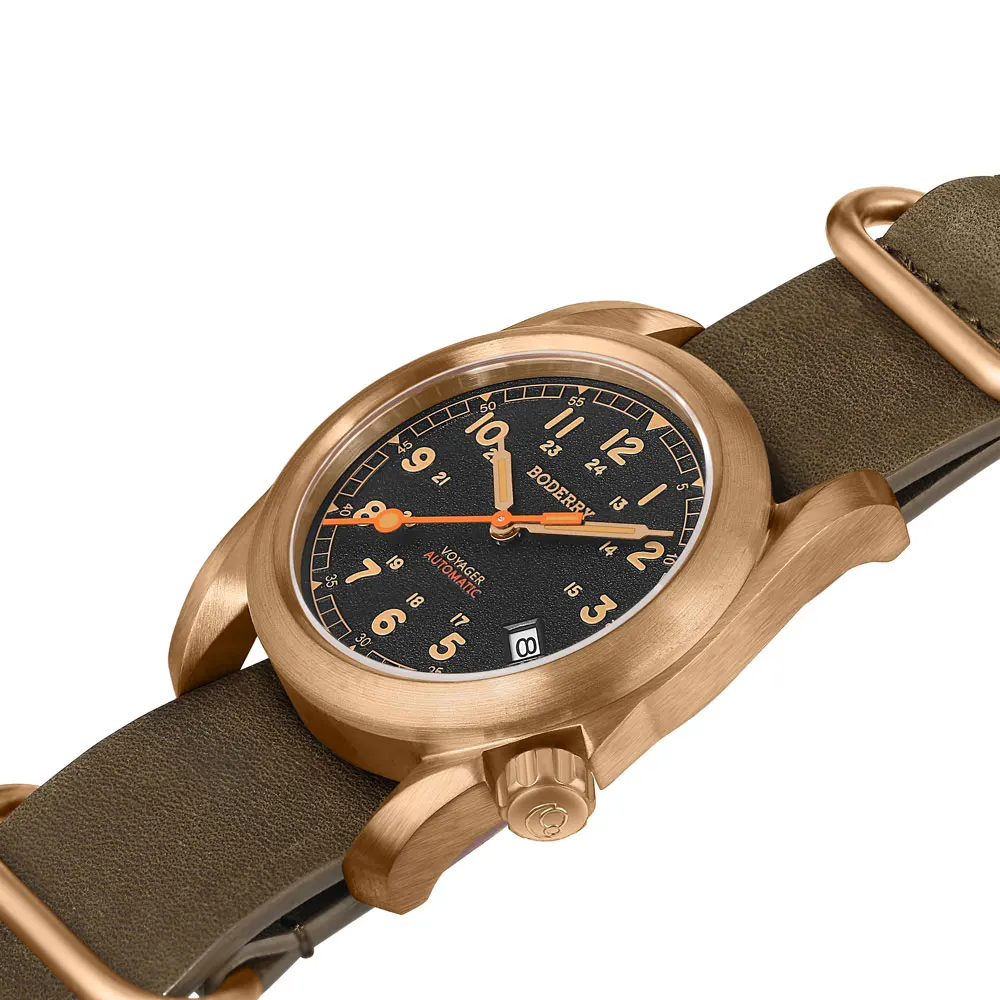
Military Inspired Automatic Watches, Rugged Automatic Watches, Tactical Automatic Watches
Price range: $852.14 through $994.60 Select options This product has multiple variants. The options may be chosen on the product pageBronze Automatic Watches, Military Inspired Automatic Watches, Professional Spec Dive Watches
Price range: $1,442.21 through $1,442.82 Select options This product has multiple variants. The options may be chosen on the product pageClassic Pilot Watches, Military Inspired Automatic Watches
$561.00 Select options This product has multiple variants. The options may be chosen on the product pageRugged Automatic Watches, Unique Automatic Watches
Price range: $228.96 through $231.10 Select options This product has multiple variants. The options may be chosen on the product pageClassic Field Watches, Military Inspired Automatic Watches
Price range: $280.87 through $338.51 Select options This product has multiple variants. The options may be chosen on the product pageAutomatic Skeleton Watches, Military Inspired Automatic Watches, Unique Automatic Watches
$191.88 Select options This product has multiple variants. The options may be chosen on the product page
When attempting forced patination, remember that different bronze alloys respond differently to these techniques—aluminum bronze typically requires longer exposure than tin bronze to achieve similar results. The goal should be creating a natural-looking result rather than an obviously artificial finish.
Slowing or Reversing Patina: Maintaining Bronze’s Original Luster
While many collectors embrace patina, others prefer to preserve the original golden appearance of their bronze watches. Whether you’re looking to maintain that factory-fresh look or restore a heavily patinated piece, several effective methods exist.
Slowing Natural Patination
To minimize patina development:
* Clean your watch regularly with mild soap and water
* Dry thoroughly after any moisture exposure, especially after swimming or sweating
* Store in low-humidity environments, ideally with silica gel packets
* Consider applying protective compounds (discussed below)
* Minimize exposure to salt water, chlorine, and other corrosive substances
Removing Existing Patina
When you want to reverse patination and restore original luster:
- Lemon Juice Method
- Apply fresh lemon juice with a soft cloth
- Gently rub in circular motions
- Rinse thoroughly and dry completely
The citric acid neutralizes and dissolves the oxide layer
Vinegar Treatment
- Create a solution of equal parts white vinegar and water
- Apply with a soft cloth or soak for 10-15 minutes for stronger effect
Rinse thoroughly afterward
Baking Soda Paste
- Mix baking soda with water to create a thick paste
- Apply gently with a soft cloth using circular motions
- Rinse completely and dry
- Particularly effective for removing uneven patination
Commercial bronze cleaners and polishes can also restore original luster, though care should be taken to avoid abrasive formulations that might scratch the case.
Protective Coatings
To maintain the restored appearance:
- Renaissance Wax – A microcrystalline wax that creates an invisible barrier against oxidation
- Mineral Oil – A thin application creates a protective film that prevents air contact
- Polymer Sealants – Modern clear coatings can provide longer-term protection
When cleaning bronze, always stop if you encounter resistance or see any signs of scratching. The goal is removing only the oxide layer while preserving the underlying metal.
The timeline of diving watch innovations reveals that material maintenance has been a crucial consideration throughout horological history. Like these historical developments, your approach to patina can be guided by both practical considerations and aesthetic preferences.
Remember that any protection is temporary—bronze’s natural tendency to oxidize means regular maintenance is necessary to preserve its original appearance indefinitely.
The Visual Spectrum: How Different Factors Create Unique Patina Colors
One of the most captivating aspects of bronze patina is its remarkable range of colors. From subtle honey golds to deep chocolates, from vibrant turquoise to olive greens, the patina palette offers incredible visual variety based on specific conditions and exposures.
Saltwater exposure typically promotes blue-green patinas rich in copper chloride compounds. These oceanic hues explain why bronze dive watches often develop such distinctive colorations when used in marine environments. The intensity of these colors usually corresponds to the duration and frequency of salt exposure.
In contrast, watches primarily exposed to freshwater and body oils tend to develop warmer brown and amber tones dominated by copper oxides. These earth tones create a vintage aesthetic many collectors prize for its subtle, sophisticated appearance.
Different bronze alloys also exhibit characteristic color tendencies. CuSn8 (tin bronze) typically produces deeper, darker patinas, while aluminum bronze tends toward lighter, more golden hues even after extensive patination. These inherent tendencies guide the color journey regardless of environmental factors.
The most fascinating patinas often come from combination exposures. A watch worn both in urban environments and occasional beach trips might develop a complex patina featuring warm browns on top surfaces with hints of green in recessed areas—a beautiful record of the wearer’s diverse experiences.
Understanding the definitive guide to bronze watch cases helps collectors appreciate how different materials respond to various environments. This knowledge allows enthusiasts to make informed choices about activities that might influence their watch’s appearance.
Temperature also influences color development. Patina formed in cooler conditions often appears slightly different than that developed in warmer environments, adding another variable to the endless combinations possible.
This remarkable color diversity ensures that each patinated bronze watch becomes a unique art piece—a living canvas that continues to evolve throughout its life with you.

Bronze Disease Warning Signs: Protecting Your Investment
While natural patina enhances bronze watches, there’s an important distinction between beneficial oxidation and destructive corrosion. “Bronze disease” is a specific form of chloride-based corrosion that can permanently damage your timepiece if not identified and addressed quickly.
Unlike normal patina that stabilizes and protects, bronze disease is an active corrosion process that continues even in dry conditions. The key difference lies in the chemistry—normal patina forms stable compounds, while bronze disease creates unstable copper chlorides that continually react with moisture and oxygen.
Warning Signs to Watch For:
- Powdery, bright green spots that appear almost crystalline
- Pitting or small crater-like formations on the surface
- Areas that remain actively changing even when the watch is stored dry
- Patina that easily flakes off rather than remaining firmly attached
- Unusual or irregular patchy coloration different from the surrounding areas
If you suspect bronze disease has begun, immediate intervention is crucial:
- Remove any visible powder using a soft brush
- Neutralize the active chlorides with a baking soda solution
- Rinse thoroughly with distilled water
- Ensure the watch is completely dry
- For severe cases, consult a professional watchmaker
Prevention is always better than treatment. After exposure to saltwater or chlorinated pools, thoroughly rinse your rugged automatic watches with fresh water and dry completely. Avoid storing bronze watches in highly humid environments where chloride reactions accelerate.
Understanding the distinction between healthy patina and destructive corrosion helps protect your investment while still enjoying the natural aging process that makes bronze watches so appealing. With proper care, your bronze timepiece will develop character without suffering damage.
Living with Your Bronze Timepiece: Embracing the Journey
A bronze watch offers something truly special in today’s world of mass-produced consumer goods—a personal artifact that visibly evolves with you. Unlike stainless steel, titanium, or precious metals that remain relatively unchanged over time, bronze creates a visual record of your experiences together.
This transformative quality connects deeply with the philosophical appeal of mechanical timepieces. Just as the movement inside your watch marks the passage of time with each tick, the case exterior records your journey through its gradually changing appearance. There’s something profoundly authentic about an object that honestly shows its age and experiences.
While understanding the factors affecting patina development is valuable, becoming too controlling about the process can diminish the joy of ownership. Consider adopting a mindful but relaxed approach—be aware of how your activities might influence patina, but don’t let this awareness prevent you from living naturally with your watch.
Different collectors find joy in different approaches. Some enthusiasts deliberately expose their watches to create specific patina patterns, others carefully maintain the original finish, and many simply wear their watches without special treatment, letting nature take its course. There’s no right or wrong approach—only what brings you personal satisfaction.
Remember that patina is an ongoing conversation between your watch, yourself, and your environment. A bronze watch worn regularly becomes more than just a timekeeping device; it becomes a unique record of your life—capturing memories of ocean swims, mountain hikes, special occasions, and everyday moments in its gradually evolving surface.
This special characteristic makes bronze watches from Sharp Aspect particularly meaningful as they age. Each develops its own personality that cannot be precisely duplicated, becoming increasingly personal with every passing day.
Frequently Asked Questions About Bronze Watch Patina
Is bronze watch patina harmful to the watch?
No, normal patina actually protects your bronze watch by forming a stable oxide layer that prevents further corrosion. This natural process is beneficial rather than harmful, provided it doesn’t develop into bronze disease (active chloride corrosion).
Can I completely prevent patina on my bronze watch?
While you can significantly slow the patination process through regular cleaning, protective coatings, and careful storage, completely preventing oxidation indefinitely is challenging. Bronze’s natural tendency to react with environmental elements makes some degree of patination inevitable over extended periods.
Will patina affect my watch’s water resistance?
Normal patina development does not affect water resistance. The critical water-resistant features depend on gaskets, crown seals, and case engineering rather than the surface appearance of the metal. However, regular maintenance checks remain important regardless of case material.
Does patina affect the value of a bronze watch?
This depends entirely on context. For many collectors, an evenly developed, attractive patina enhances a bronze watch’s appeal and may increase its value on the secondary market. For others who prefer pristine appearance, heavy patination might be less desirable. Unlike tarnish on silver or corrosion on steel, bronze patina is generally considered a feature rather than a flaw.
Can I reverse patina if I don’t like how it develops?
Yes, patina can be removed using gentle acidic solutions like lemon juice or vinegar, or with commercial bronze cleaners. The original finish can be restored relatively easily, allowing you to “reset” the patination process if desired.
Is forced patina “cheating”?
The watch community holds diverse opinions on this question. Some enthusiasts view artificially accelerated patina as circumventing the personal journey a watch should take with its owner. Others see it as simply taking control of an inevitable process to achieve a desired aesthetic. Ultimately, how you choose to approach your watch’s patination is a personal decision with no objectively right or wrong answer.

